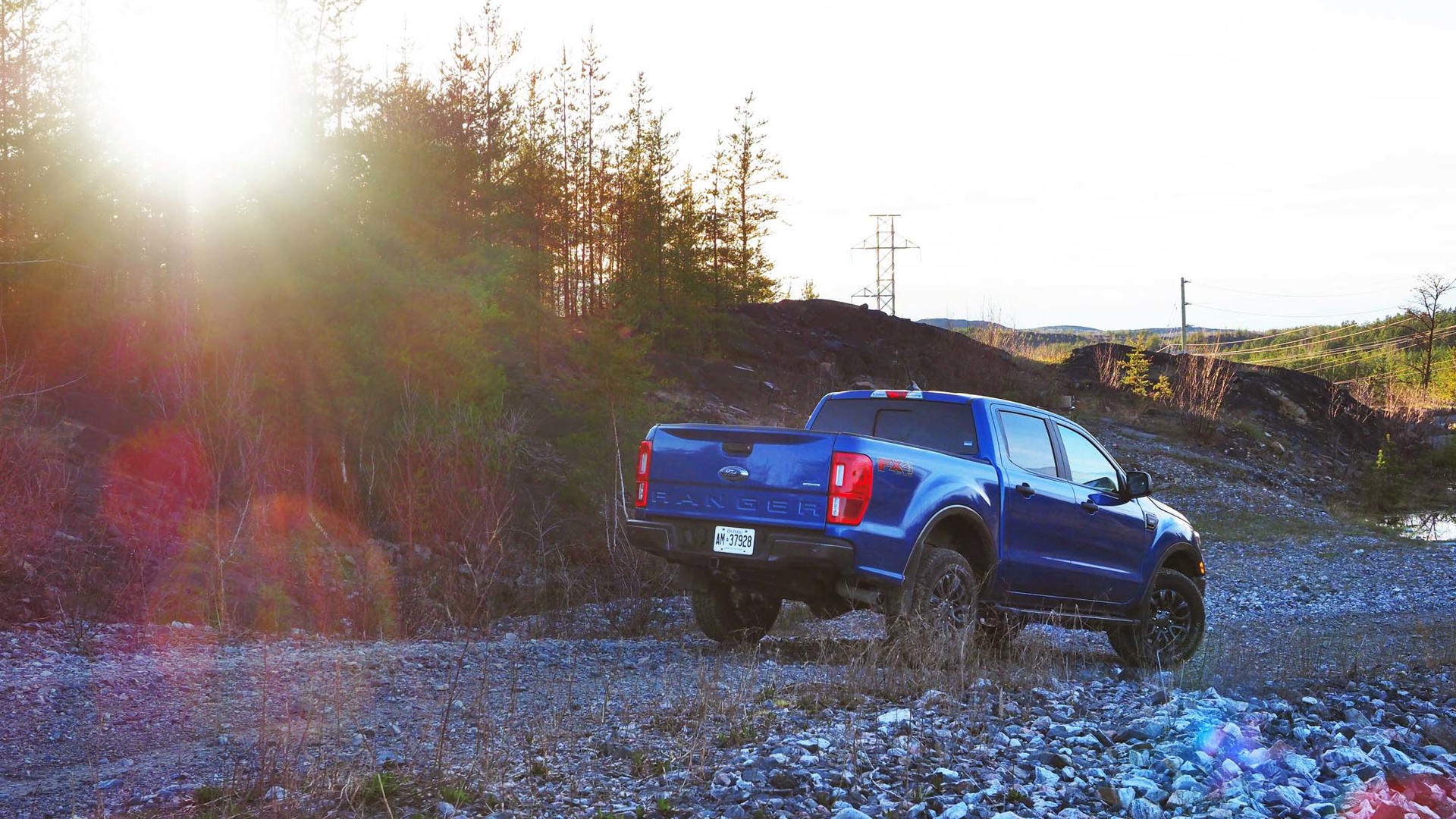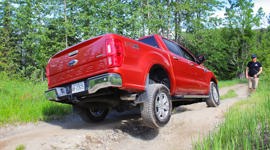 AutoTrader SCORE
AutoTrader SCORE
-
STYLING7/10
-
Safety8/10
-
PRACTICALITY7/10
-
USER-FRIENDLINESS7/10
-
FEATURES7/10
-
POWER9/10
-
COMFORT9/10
-
DRIVING FEEL9/10
-
FUEL ECONOMY7/10
-
VALUE8/10
Ford’s reincarnated Ranger nameplate resurrects a pickup sales superstar from years gone by. The 2019 Ford Ranger competes with the Toyota Tacoma, GMC Canyon / Chevrolet Colorado, Honda Ridgeline, and Nissan Frontier – as well as full-sized trucks – since it gives shoppers yet another mid-sized option that may better match their specific needs and tastes.
The Ranger is smaller, easier on fuel, more manoeuvrable, and easier to drive for some than the larger F-150 – though it shares plenty of hardware, technology, and even a torture-testing regimen with its bigger brother. Other than a dated interior and a curiously absent feature or two, it stacks up as a compelling choice in the segment.
Styling: 7/10
The new Ranger is styled with enough Ford DNA to make it easy to spot on the road, and instantly identifiable from a mere glance. Extra touches like the “Ranger” stamped tailgate and seamless rear window add some modern flair, and most shoppers will appreciate the front fascia, which looks rugged and athletic, but not overdone.
In all, the Ranger has an eager stance and a distinctive look – though some may find its fascia looks like it was morphed from a few-year-old Ford sedan, and wish for something a little more aggressive.
Further, the Ranger’s interior styling isn’t trying to win any beauty contests, as pickup cabins go. Though arranged logically and peppered with a few upscale touches, much of the switchgear, plastics, interfaces and controls will be familiar to shoppers coming into the Ranger from a few-year-old Ford sedan or crossover. It’s a brand-new truck in our market, though parts of the interior are looking dated already.
Safety: 8/10
My FX4 tester offered roughly average outward visibility, which was enhanced by blind spot monitoring, a high-quality back-up camera system, and parking radar. Mirrors are appropriately sized and shaped, too. High-end safety tech includes radar cruise control and lane-departure alert. Both systems work as smoothly and seamlessly as you’d expect in a big-dollar premium car, and both are easily switched on and off as required.
Braking feel is slightly more precise than the norm in this segment, and the brakes perform adequately when called upon – though the included Hankook DynaPro tires feel like they could offer a little more grip during hard stops on bare pavement. Headlight performance after dark is about average for the segment.
Practicality: 7/10
The Ranger’s practicality will largely prove a function of how well the size and proportions of the truck match up with your needs, lifestyle, and activities. Two body styles are available, my tester had the SuperCrew setup for a larger cabin and a smaller box.
Entry and exit are handled with a hop rather than a jump, though a Honda Ridgeline will prove easier to board and exit for larger, shorter, or limited-mobility passengers – partly since it sits closer to the ground and mostly because it has a lower floor and larger door openings.
Finally, the Ranger’s rear seating may limit practicality for some users, too. With the seats in place, there’s adequate space for two average-sized adults, little more. When more cargo space is needed, the seat bottom flips up in its entirety – meaning you can use the rear of the cab for two passengers, or cargo, but nothing in between. With the seat bottom flipped up, various bins moulded into the floor create a relatively lumpy and uneven surface for cargo or pets to rest on.
User Friendliness: 7/10
The Ranger’s steering becomes light and lazy at lower speeds, while a respectable turning circle further eases manoeuvrability in tight quarters. Use during a day of running errands around town should prove no issue.
The central touchscreen interface takes user friendliness to the max since it’s logical, responsive, and intuitive enough to learn in just a few minutes. Even first-time users will have the system licked in quick order, and the need to call your nearest teenager for help is unlikely.
Steering-wheel-mounted controls for common functions, as well as features like automatic lights and climate control, add further convenience, as does the slick radar cruise control system.
The Ranger’s 4x4 system is operated by an electronic dial that toggles various 4x4 modes in seconds, and drivers are backed by a slick network of off-road support systems, too.
With a twist of a dial or a few button presses, drivers can engage specialized modes for various challenging terrain conditions, activate the rear differential lock, or engage Trail Control, which works like off-road cruise control. With Trail Control activated, users specify a set speed (perhaps 3 km/h), and the Ranger’s electronics maintain that speed, regardless of traction, terrain, or incline. This leaves the driver solely to focus on steering and manoeuvring.
The state of these support systems, and others, is clearly displayed in the partially digital instrument cluster for easy reference and adjustment.
Finally, the Ranger provides passengers with adequate at-hand storage for smaller items, and plenty of charging ports – though I left my tester wishing for climate controls that were easier to see and read.
Features: 7/10
The Ranger packs most of the features that today’s pickup shopper may fancy, though it may leave some shoppers wanting a little “more”.
Though the modern-day must-haves are mostly in attendance, my tester lacked fully powered seats, instead using motorized and mechanical adjustments in tandem. And, despite being equipped with radar cruise control and lane-departure alert, it used an old-school mechanical key and remote keyfob for the ignition and locks.
Further, note that while the 4x4 system has 2WD, 4x4 High and 4x4 Low settings, no fully automatic setting is available – so you’ll have to remember to switch four-wheel traction on when you need it. The Ridgeline and Colorado / Canyon, for instance, offer automatic 4x4 systems, if that’s important to you.
All said, most test drivers will find the Ranger’s most valuable feature content to be its advanced safety tech, advanced off-road tech, and slick central command interface.
Power: 9/10
By the numbers, and the performance experienced from the driver’s seat, most test drivers will find the Ranger to have the most compelling powertrain in the segment. All models use a 2.3-litre four-cylinder turbocharged EcoBoost engine that’s small but mighty.
With 270 horsepower backed by 310 lb-ft of torque (available from remarkably low revs), drivers can expect class-leading torque and excellent low-rpm throttle response. From on-board, this means Ranger is quieter, and feels more effortless, more of the time. In city traffic, there’s barely a need to get the engine revving past about 2,500 rpm. Even small throttle inputs get this little torque-monster sailing along with authority.
Passing and merging power are top-notch, and may even prove a little excessive for some drivers.
The standard 10-speed automatic transmission helps the engine use less revs, more of the time, to the benefit of fuel mileage. With 10 gears available, and the ability to skip multiple gears in each direction when appropriate, this transmission also benefits acceleration when requested.
Other than a few clumsy or misplaced shifts, the gearbox operated with virtually invisible smoothness. Those test-driving Ranger against its competitors will likely find it to offer the snappiest, quietest, and most refined powertrain on the scene right now.
Comfort: 9/10
During a highway cruise, noise levels are kept appropriately muted to just beyond the highway speed limit, and the steering feel heavies at your fingertips to help lock you into your position between the lines, but without feeling too labour-intensive when you need to steer. Put another way, the steering feel is nicely set up for easygoing cruising.
I noted no issues with seat comfort; at 5'10" with an athletic build, experienced sufficient (though not abundant) space in each direction around me. Leggier drivers may be at risk of having their right knee crowded by the centre console, however.
Driving Feel: 9/10
Big news first: the suspension is set up remarkably well for comfort on virtually all surfaces.
Even with the beefed-up FX4 suspension, the Ranger keeps ride quality and body motions nicely under control, and does an excellent job of filtering the harshest sensations from entering the cabin.
Specifically, on rougher paved roads, it feels durable and tough – complete with that rigid jouncy-jiggle that many pickup drivers appreciate. Whack a pothole, and you’ll likely feel sorrier for the pothole than the Ranger’s suspension. It’s finely tuned, and feels solid throughout.
On trails, it’s much the same. You know you’re in a truck, but the Ranger rarely feels like it’s taking any abuse, or at risk of damage, even when used harshly. Even sequential moguls that cause the front wheels to leave the ground briefly cause little break in the composure of the ride.
Finally, on smooth roads and highways, you mostly feel like you’re driving a big, tall, heavy car.
The gist? Most pickup fans will find the Ranger rides just how they like on any surface, though you might want to skip the off-road package if you find the FX4 shocks feel too stiff.
Fuel Economy: 7/10
The Ranger’s fuel economy is rated at a combined 10.9 L/100 km. City consumption lands at 11.8 L/100 km and highway consumption lands at 9.8. The combined figure puts the Ranger ahead of models like the Tacoma and Ridgeline where consumption is concerned, despite offering a considerable torque advantage. During my time with the Ranger, I felt my fuel dollars were being put to good use by the punchy and relatively efficient engine.
Value: 8/10
Provided shoppers are accepting of the Ranger’s dated cabin, relatively inflexible on-board cargo storage, and curiously absent features, this model should stack up nicely as one that feels rugged and comfortable, turns in decent fuel mileage, and is easy to use in almost every situation.
Conclusion
Those planning to get into weekend off-roading will find no shortage of useful technology to assist them, and experienced off-roaders will feel very nicely backed up, especially with an FX4 model, like my tester. All in all, the Ranger stacks up nicely – though cross-shopping all competitors is highly advised to make sure it’s the right choice for you.
| Engine Displacement | 2.3L |
|---|---|
| Engine Cylinders | I4 |
| Peak Horsepower | 270 hp @ 5,500 rpm |
| Peak Torque | 310 lb-ft @ 3,000 rpm |
| Fuel Economy | 11.8/9.8/10.9 L/100 cty/hwy/cmb |
| Cargo Space | 5' box |
| Model Tested | 2019 Ford Ranger XLT 4x4 SuperCrew |
| Base Price | $36,939 |
| A/C Tax | $100 |
| Destination Fee | $1,900 |
| Price as Tested | $45,389 |
|
Optional Equipment
$6,450 – Package 302a $3,500; FX4 Off-Road Package $1,400; Technology Package $850; Running Boards $700
|
|























































